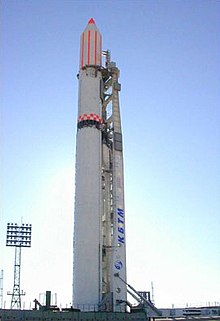
Back زينيت (صاروخ) Arabic Зенит (ракета) Bulgarian زێنیت (مووشەک) CKB Zenit (nosná raketa) Czech Zenit (Trägerrakete) German Zenit (cohete) Spanish موشک زنیت Persian Zenit (rakettiperhe) Finnish Zenit (fusée) French זניט (משגר לוויינים) HE
 Zenit-2 rocket (Baikonur, 10 December 2001) | |
| Function | Medium-lift expendable carrier rocket |
|---|---|
| Manufacturer | |
| Country of origin | |
| Size | |
| Height | 57–59.6 m (187–196 ft) |
| Diameter | 3.9 m (13 ft) |
| Mass | 444,900–462,200 kg (980,800–1,019,000 lb) |
| Stages | 2 or 3 |
| Capacity | |
| Payload to LEO | |
| Mass | Zenit-2: 13,740 kg (30,290 lb) |
| Payload to SSO | |
| Mass | Zenit-2: 11,380 kg (25,090 lb) |
| Payload to GTO | |
| Mass | Zenit-3SL: 6,000 kg (13,000 lb) |
| Launch history | |
| Status | Suspended |
| Launch sites | |
| Total launches |
|
| Success(es) |
|
| Failure(s) |
|
| Partial failure(s) |
|
| First flight |
|
| Last flight |
|
| First stage | |
| Powered by | 1 RD-171 |
| Maximum thrust | 8,180 kilonewtons (1,840,000 lbf) |
| Specific impulse | 337 seconds (3.30 km/s) |
| Burn time | 150 seconds |
| Propellant | RP-1 / LOX |
| Second stage | |
| Powered by | 1 RD-120 1 RD-8 |
| Maximum thrust | 912 kilonewtons (205,000 lbf) 79,500 newtons (17,900 lbf) |
| Specific impulse | 349 seconds (3.42 km/s) |
| Burn time | 315 seconds |
| Propellant | RP-1/LOX |
| Third stage (Zenit-3SL/3SLB) – Block DM-SL | |
| Powered by | 1 RD-58M |
| Maximum thrust | 84,900 newtons (19,100 lbf) |
| Specific impulse | 352 seconds (3.45 km/s) |
| Burn time | 650 seconds |
| Propellant | RP-1 / LOX |
| Third stage (Zenit-3F) – Fregat-SB | |
| Powered by | 1 S5.92 |
| Maximum thrust | 19,600 newtons (4,400 lbf) |
| Specific impulse | 327 seconds (3.21 km/s) |
| Burn time | 877 seconds |
| Propellant | N2O4 / UDMH |
Zenit (Ukrainian: Зеніт, Russian: Зени́т; meaning Zenith) was a family of space launch vehicles designed by the Yuzhnoye Design Bureau in Dnipro, Ukraine, which was then part of the Soviet Union. Zenit was originally built in the 1980s for two purposes: as a liquid rocket booster for the Energia rocket and, equipped with a second stage, as a stand-alone middle-weight launcher with a payload greater than the 7 tonnes of the Soyuz but smaller than the 20 tonnes payload of the Proton. The last rocket family developed in the USSR, the Zenit was intended as an eventual replacement for the dated Soyuz and Proton families, and it would employ propellants which were safer and less toxic than the Proton's nitrogen tetroxide/UDMH mix. Zenit was planned to take over crewed spaceship launches from Soyuz, but these plans were abandoned after the dissolution of the Soviet Union in 1991.
Many of components of the Zenit rockets were produced in Russia. The Ukrainian space industry was highly integrated with that of Russia due to its Soviet heritage, but that cooperation was interrupted by the Russo-Ukrainian War beginning in 2014, which has effectively led to a hiatus in the Zenit program.[2] The subsequent Russian invasion of Ukraine in 2022 saw damage to its manufacturing facilities due to Russian missile strikes, and what survived those strikes pivoted to producing military weapons.[3]
Zenit-3SL was launched by the Sea Launch consortium's floating launch platform in the Pacific Ocean and Zenit-2 was launched from Baikonur Cosmodrome in Kazakhstan. RD-171M engines of the Zenit's first and second stages as well as the upper stage of the Zenit-3SL rocket were supplied by Russia. An improved Zenit-3SLB rocket was used for commercial launches from Baikonur Cosmodrome beginning in April 2008, marketed as Land Launch.[4]
Zenit-3SL was launched 36 times with 32 successes, one partial success, and three failures. The first failure, the launch of a Hughes-built communications satellite owned by ICO Global Communications, occurred during the second commercial launch on March 12, 2000, and was blamed on a software error that failed to close a valve in the second stage of the rocket. The second failure occurred on January 30, 2007, when the rocket exploded on the Odyssey launch platform, seconds after engine ignition. The NSS-8 communication satellite on board was destroyed.[5]
On September 24, 2011 Zenit-3SL launched successfully from the Odyssey launch platform under a renewed Sea Launch project with RSC Energia as the majority stakeholder. The rocket delivered the European communication satellite Atlantic Bird 7 to its planned orbit. On February 1, 2013, another Zenit-3SL failed while launching the Intelsat 27 satellite.[6]
- ^ Израиль корит Роскосмос за невыполненные обязательства (in Russian). Izvestia. 2008-05-06. Archived from the original on May 10, 2008. Retrieved 2008-05-09.
- ^ Bodner, Matthew (June 6, 2016). "How Crimea's annexation hurt Ukraine's space program". SpaceNews. Retrieved 2024-04-02.
- ^ Pultarova, Tereza (2023-08-27). "Lost partnerships destroying Ukraine's space sector faster than Russian missiles, former space chief says". Space.com. Retrieved 2024-04-02.
- ^ "Land Launch User's Guide Revision B" (PDF). Space International Services. 1 October 2014. Archived from the original (PDF) on 25 June 2016. Retrieved 8 February 2015.
- ^ Harvey, Brian (2007). The Rebirth of the Russian Space Program. Chichester, UK: Praxis. pp. 167–175.
- ^ Bergin, Chris (1 February 2013). "Sea Launch Zenit 3SL with Intelsat 27 fails during first stage flight". NASASpaceflight.com. Retrieved 1 February 2013.
© MMXXIII Rich X Search. We shall prevail. All rights reserved. Rich X Search